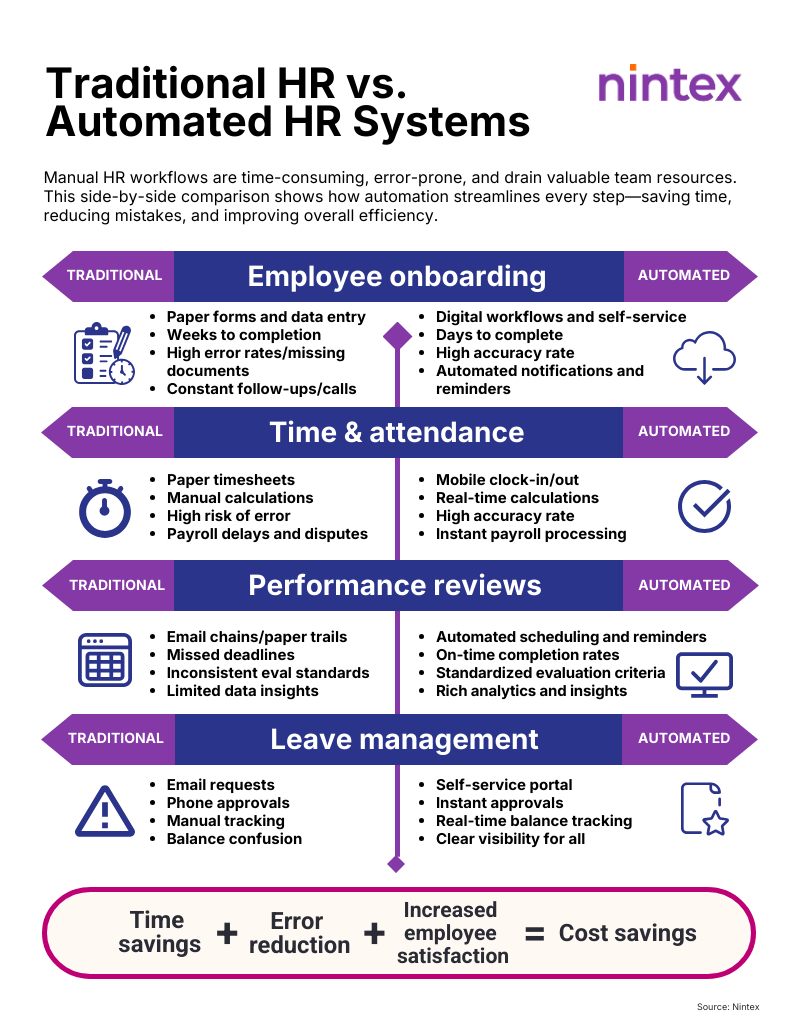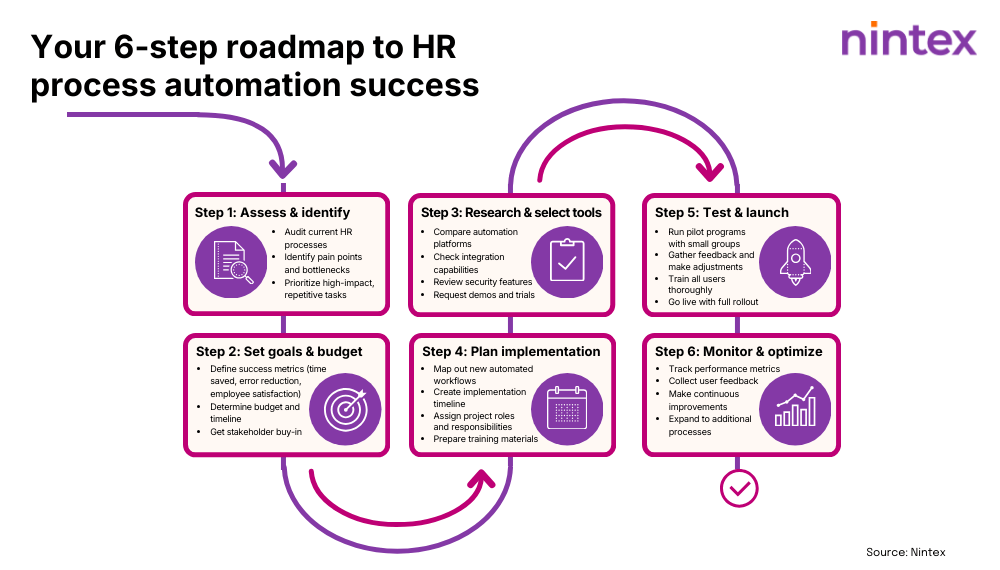Running a business today can feel like trying to keep up with a moving train. Everything happens faster, and there’s constant pressure to do more with less. If you’re in HR, you know this feeling all too well. You’re juggling employee onboarding, managing performance reviews, tracking vacation requests, and somehow trying to stay on top of ever-changing compliance requirements.
But you don’t have to do it all manually anymore. HR process automation isn’t just another buzzword — it’s changing how smart companies handle their people operations. Think of it as having a reliable assistant that never sleeps, never makes calculation errors, and never forgets to send that important reminder email.
When you automate routine HR tasks, your team stops drowning in paperwork and starts focusing on what really matters — building relationships with employees, developing talent strategies, and creating a workplace people want to be part of. Plus, you’ll sleep better knowing that compliance deadlines won’t slip through the cracks.
Of course, jumping into automation isn’t something you do on a whim. It takes some upfront thinking about which processes will give you the biggest bang for your buck, and choosing the right tools that fit how your organization works. The good news? You don’t have to figure it all out overnight.
What’s exciting is where this technology is headed. We’re starting to see AI and machine learning make HR systems genuinely smart — meaning they aren’t just automated, but helpful in predicting what your workforce needs before problems arise.
HR process automation definition
HR process automation involves the usage of technology to simplify and optimize human resources (HR) tasks and procedures. It involves automating repetitive and labor-intensive HR activities, such as employee onboarding, leave management, performance reviews, and payroll processing.

Understanding HR process automation
When you stop doing everything by hand, you get your life back and your employees get a better experience. HR process automation cuts out those mind-numbing data entry tasks that eat up your day and inevitably lead to mistakes. Instead of hunting down missing forms or chasing people for approvals, you can work on things that move the needle.
HR process automation also helps you manage compliance. You know that sinking feeling when you realize you missed a deadline or forgot to document something important? Automation basically puts guardrails around your processes, so everything follows the same path every time. No more wondering if you’re meeting regulatory requirements — the system keeps you on track.
And with HR process automation, your employees can finally handle simple stuff themselves. Need to request time off? Done in two clicks. Want to update their emergency contact? No need to fill out a form and wait three weeks. When people can take care of basic tasks without jumping through hoops, everyone’s happier.
The tools that make HR process automation work aren’t rocket science, but they’re pretty clever. You get workflow builders that let you map out exactly how things should happen in your organization — no more guessing or hoping someone remembers the right steps. Document management keeps everything organized and searchable, so you’re not digging through file cabinets or email chains looking for that one contract from two years ago.
And with smart alerts and reminders, performance review season doesn’t sneak up on you anymore, and new hire paperwork doesn’t pile up on someone’s desk. The system keeps track of what needs to happen when, so nothing important gets forgotten.
What’s especially powerful is how these tools talk to each other. When you choose the right HR process automation platform, it doesn’t live in isolation — it connects with your existing systems so information flows seamlessly. No more entering the same data in three different places or trying to reconcile conflicting information between systems.

How HR process automation can benefit your organization
HR process automation can significantly enhance your organization by streamlining various HR tasks and boosting overall efficiency:
Streamlining employee onboarding and offboarding: Remember the last time you onboarded someone and it felt like herding cats? There’s the IT setup, the paperwork, the training schedule, the introductions — it’s a lot to coordinate. With HR process automation, you can set up workflows that handle all this automatically. New hires get their welcome packet, know exactly what to do on day one, and don’t fall through the cracks. Same goes for when people leave — the system makes sure they return their laptop, their access gets revoked, and nothing important gets missed.
Efficient time and attendance management: Timesheets are the bane of everyone’s existence, right? People forget to fill them out, managers forget to approve them, and payroll gets delayed because someone’s math doesn’t add up. When you automate time tracking, employees just clock in and out, and the system handles the rest. No more chasing people for their hours, no more payroll surprises, and no more wondering if you’re calculating overtime correctly.
Automating payroll processing for accuracy and efficiency: Payroll is one of those things that absolutely cannot go wrong, but it’s incredibly easy to mess up when you’re doing it manually. HR process automation takes care of the calculations, tax withholdings, and deductions automatically. Your people get paid correctly and on time, every time. Plus, you’re not pulling all-nighters during payroll week trying to make sure everything balances.
The bottom line? When you implement HR process automation thoughtfully, your team becomes more productive, you spend less time on administrative busywork, and your employees have a much better experience with HR processes.
Best practices for implementing HR process automation
Implementing HR process automation can significantly streamline and enhance the efficiency of your HR department. However, it’s important to adhere to best practices to ensure a successful implementation. Here are some key considerations:
Identifying the right HR processes to automate: Don’t try to automate everything at once — that’s a recipe for chaos. Start by looking at your biggest pain points. Which processes have your team working late? Where do mistakes happen most often? Usually, things like employee onboarding, time-off requests, performance reviews, and benefits enrollment are great candidates because they involve a lot of back-and-forth and paperwork. Pick one or two processes to start with, get those working smoothly, then gradually expand from there.
Ensuring data security and compliance: This isn’t something to take lightly. You’re dealing with people’s personal information, salaries, and sensitive company data. Make sure whatever HR process automation tool you choose has solid security features — things like role-based access (so only the right people see the right information), encryption for data protection, and audit trails so you know who did what and when. Also, double-check that it meets whatever regulations apply to your industry, whether that’s GDPR, CCPA, or other data protection rules.
Training employees to adapt to automation: Change is hard, and some people might be nervous about new technology replacing their familiar processes. Be upfront about what’s changing and why it’ll make their lives easier. Run training sessions before you go live, not after. Create simple how-to guides and maybe even record quick video tutorials. Most importantly, have someone available to answer questions during the first few weeks. When people feel supported through the transition, they’re much more likely to embrace the new system.
Follow these practices and you’ll avoid most of the common pitfalls that trip up HR process automation projects. The key is taking it step by step rather than trying to revolutionize everything overnight.

Selecting the right HR process automation tool
When it comes to choosing an HR process automation tool, there are several factors to consider when choosing the right solution for your organization’s needs. Here are some key considerations:
Integration capabilities with existing HR systems: This is probably the most important thing to get right. Your new automation tool needs to play nicely with whatever systems you’re already using, like your HRIS, payroll software, and applicant tracking system. If it can’t integrate smoothly, you’ll end up with more headaches than you started with. Look for tools that have pre-built connections to popular HR platforms, or at least solid APIs that your IT team can work with. The last thing you want is to be manually transferring data between systems because they don’t talk to each other.
Case studies of successful HR process automation implementations: Don’t just take the provider’s word for it — dig into real examples of companies like yours that have successfully implemented their solution. Look for case studies from organizations in your industry or of similar size. Pay attention to what challenges they faced, how long implementation took, and what results they achieved.
Here’s the thing about selecting HR process automation tools: there’s no one-size-fits-all solution. What works great for a 50-person startup might be overkill for a bigger company, and what serves a manufacturing company well might not fit a consulting firm. Take the time to really understand your specific needs, get demos that focus on your use cases, and don’t be afraid to ask tough questions about implementation timelines and ongoing support.
Future trends in HR process automation
As technology continues to evolve, the future of HR process automation is set to be transformed by artificial intelligence (AI) and machine learning. These advanced technologies have the potential to revolutionize the way HR professionals manage and streamline their procedures.
We’re moving beyond simple “if this, then that” automation into genuinely smart systems. AI and machine learning can crunch through massive amounts of data to spot patterns you’d never notice on your own. Imagine a system that can predict which employees might be thinking about leaving before they even start updating their LinkedIn profiles, or recruitment tools that can identify the best candidates not just based on their resume keywords, but on subtle patterns that indicate long-term success at your company.
And HR process automation is becoming more personalized. New hires might get different onboarding experiences based on their role, location, or even their learning style. Performance review cycles could adapt based on individual career goals and management preferences. An intelligent system understands what each person needs instead of treating everyone the same.
Now, let’s address the elephant in the room: will HR professionals become obsolete? Not a chance. If anything, HR process automation is going to make the human side of HR more important than ever. Sure, the system can handle routine tasks and even make smart recommendations, but you still need people to interpret the data, handle complex employee situations, and make judgment calls that require empathy and understanding. The role is evolving from administrative task manager to strategic partner, and that’s exciting.
The future of HR process automation isn’t about replacing human judgment — it’s about giving HR professionals better tools and more time to focus on what really matters: helping people succeed at work.
FAQ
- What is HR process automation?
HR process automation uses technology to simplify and automate HR tasks, improving efficiency and reducing errors. - What are some examples of HR automation?
Examples include automated onboarding, payroll processing, and performance evaluations. - How does HR automation improve compliance?
By standardizing procedures, HR automation ensures that organizations adhere to regulations and reduces the risk of non-compliance. - What should I consider when selecting an HR automation tool?
Consider integration capabilities, user-friendliness, and the specific HR processes you want to automate.
